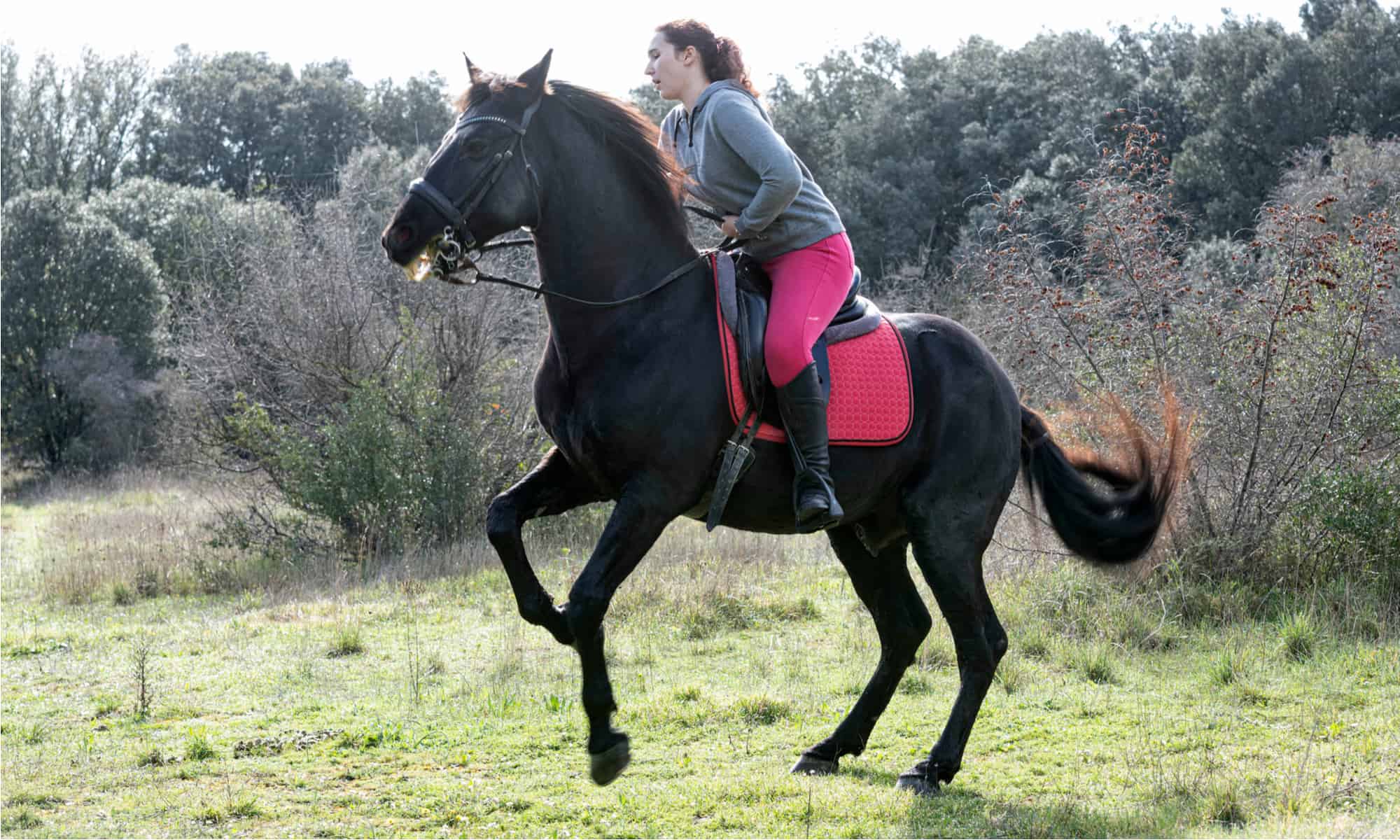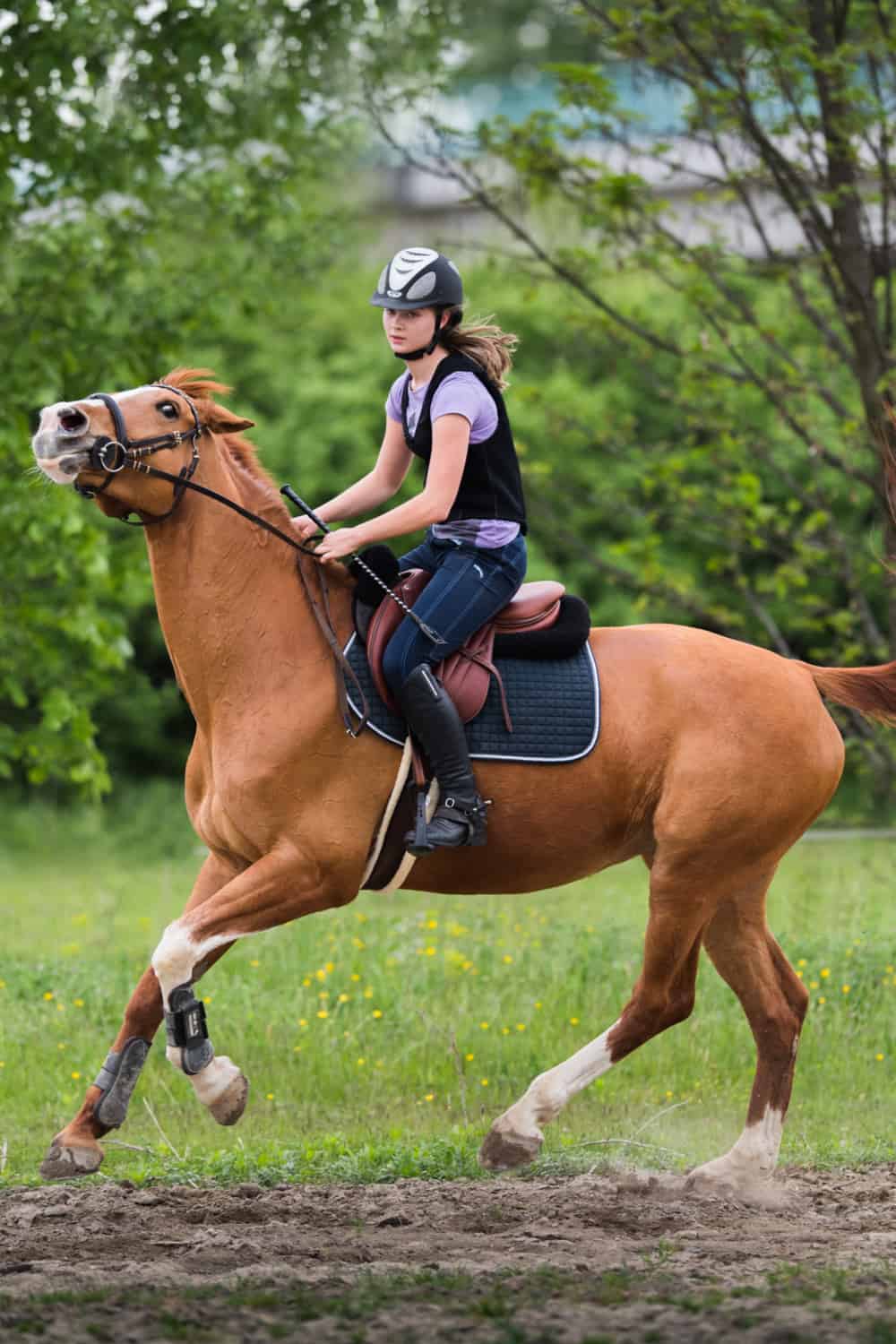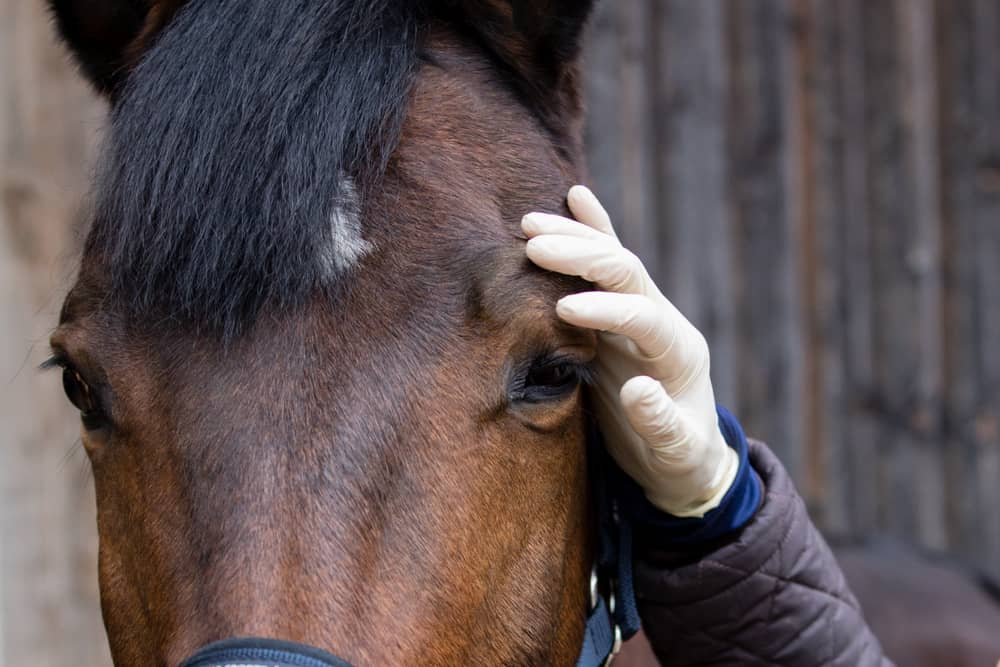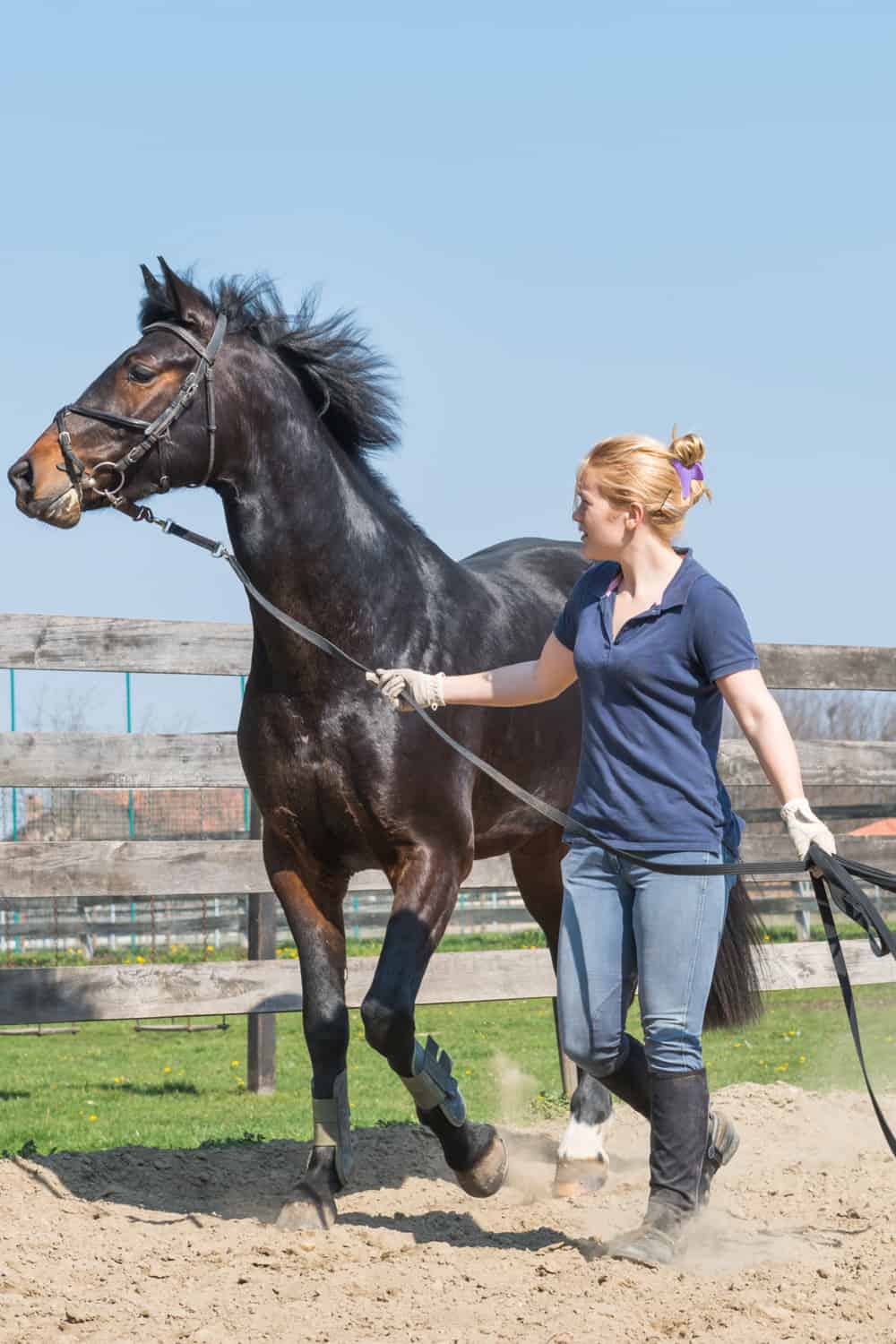Rearing is when a horse tries to move backwards. It often involves the front hooves leaving the ground, and for a rider or handler, it can be very scary. So if your horse has a tendency to rear, you’ll want to find out what’s causing it
That’s where we can help. We’re going to look at 10 reasons for your horse rearing. We’ll help you get to the bottom of what’s going wrong, and suggest ways you can put it right.
So step this way to find out more …
1. A painful saddle
Almost all rearing will result from a specific cause – usually some form of anxiety or discomfort. A good place to start working out why your horse is rearing, then, is to identify potential sources of pain. The saddle is a prime candidate for this.
If a saddle is too big or too small, it can cause a lot of discomfort to your horse. Too long, and it can dig into his spine or shoulder blades. And if its too far back, the rider’s weight can press on his kidneys.
You want your saddle to sit between the horse’s eighth and eighteenth thoracic vertebra.
To find the eighth thoracic vertebra, known as T8, start by finding the scapula. This large curving bone will be visible near the base of the horse’s neck. Run two fingers directly upwards from the edge of the scapula, and you’ll be at T8.
The 18th thoracic vertebra, T18, is situated above the horse’s last rib – that’s the rib nearest his tail. Follow the line of the rib upwards with your fingers. It will curve gently forwards, rather than going straight up. Just above the top of the rib is T18.
This YouTube video from Kate Ballard of the Society of Master Saddlers shows you how to find both vertebra. Marking them with my some sticky paper dots will help you see where your saddle needs to go.
When fitting saddles, try to get your horse standing on as even a surface as you can. The two nails at the point of the tree of your saddle need to sit at T8.
Saddle width is important too. You want to be able to get three fingers stacked on top of each other between the horse’s withers and the lowest point of the saddle gullet.
You also want an imaginary line running through the middle of the saddle, from the front to the back, to be level. If it isn’t, the saddle will rock as the horse moves, constantly moving the rider’s weight.
If you’re in any doubt about whether your saddle is correctly fitted, seek help from a qualified saddle fitter. You’ll save both your horse and yourself a lot of misery.
2. The wrong bit
This fits into the same category as an incorrectly fitted saddle – it’s another thing that can cause your horse pain.
You should always use the mildest bit possible to manage your horse. But even a soft bit that’s not the right size can result in a lot of discomfort.
A bit that’s too small will pinch the horse’s mouth. And one that’s too large will knock painfully against his teeth, causing damage.
3. The wrong cinch or girth
Just as with other parts of the horse’s tack, a cinch or girth that’s the wrong size or fit can cause pain. It should come straight down from the saddle and fit comfortably around the horse’s natural girth.
When correctly tightened, there should be just enough room underneath to fit your index finger. A cinch that’s too tight can result in a painful back for both the horse and the rider. And it’s likely to lead to problematic behaviour, such as rearing.
You can find hints and tips on ensuring the cinch fits correctly here.
4. Over-pulling the reins
One common mistake for riders, particularly those anxious or new to riding, is to pull too tightly on the reins. By doing so, you’ll be pulling up the horse’s head. That’s exactly the motion that takes place when the horse begin to rear.
In other words, you’ll be encouraging the very behavior you want to avoid.
The best way to overcome this is to take riding lessons until you overcome your anxiety. A relaxed and happy rider is far more likely to find they have a relaxed and happy horse. You can also try holding onto a neck strap as you ride.
5. Health problems
If you’ve checked equipment-related issues but your horse is still rearing, consult a vet. It may be that your horse is suffering pain from some form of health condition. Checking with a vet can rule out any such causes, and put your mind at rest.
Remember that it could also be painful teeth that are to blame. So get your vet or equine dentist to check out your horse’s nashers too.
A clean bill of health will enable you to concentrate on other possible causes for your horse’s behavior.
6. Poor eyesight
if you’ve ruled out sources of pain, the next thing to consider is anything that might be making your horse fearful.
Deteriorating eyesight can be a cause of anxiety, especially if he’s in an unfamiliar environment. While horses usually have good vision, just like humans they can develop cataracts and other eye problems.
If your horse is rearing when he’s in new surroundings, this may well be a factor. Ask your vet to check your horse’s vision for any issues.
If poor eyesight is the culprit, try to stick to riding in places your horse knows well.
And take extra care to reassure him. Speaking to him in a soft, low voice will help. You can also try aromatherapy. A few drops of lavender or peppermint oil on your horse’s bridle can help counteract stress.
7. Confusion
Some horses will react to confusion by rearing. That’s particularly likely to stem from a conflict between wanting to do as their riders ask, but not understanding how.
This can sometimes result from a rider inadvertently mixing messages. You could, for example, urge your horse forward while unintentionally hanging on his mouth. Like pulling on the reins, it’s a mistake it’s all too easy to make if you’re feeling anxious.
If that’s the problem, riding lessons can again be the way to fix it. Become a relaxed rider, and you’ll be able to keep your horse moving forward in a relaxed motion.
In other cases, a horse’s confusion can be a training issue. In that case, be prepared to spend some time with a reputable trainer to iron it out.
8. Disobedience
Like all of us, sometimes horses simply don’t want to do as they’re told! And if they discover that rearing is an effective way of getting out of something, they will do it all the more.
The most successful approach is to nip it in the bud as soon as it starts. If at all possible, don’t dismount when your horse rears. Instead, get him immediately back to work. Use one rein, moving him first in one direction, then in the other.
Moving in this way will require your horse both to go forward and to concentrate on his footwork. Neither of those things are compatible with rearing! And it will reinforce the message that rearing doesn’t allow him to get his way.
Of course, rearing can be frightening. If you don’t have the confidence to stay mounted, engage a trainer as soon as possible. It’s important to take corrective action before the behavior becomes established.
9. Boredom or excess energy
Boredom or simply too much pent-up energy can also lead to rearing in horses. Yes, the devil makes work for idle hooves!
You can address this in a number of ways – increasing his energy use, adjusting his diet and finding distractions.
A relatively simple way of increasing the amount of energy your horse uses is to turn him out more often. That can eat up that excess energy and make him less sparky when it comes to riding.
When it comes to diet, make sure you’re feeding your horse the right amount for his size and workload. Cutting back on high energy foods may improve matters. Check out this guide from the charity World Horse Welfare to ensure your horse isn’t overeating.
Some horses also respond well to toys or horse mirrors. The latter can give them the company of what appears to be another horse.
But if you try these kind of techniques, monitor your horse’s reaction. While mirrors work beautifully for many horses, some can become aggressive and even attack their reflections.
So make sure you also purchase a mirror designed for horses. These are made of acrylic, so they won’t injure your horse if he reacts badly. And take care where you position it. Research suggests the best location is just inside the stable door, away from the feed bowl.
10. Signalling dominance
Some horses can rear to signal dominance. This behavior is usually found only in stallions, who would rear in the wild to establish dominance over a rival male. And it is most likely to occur when there is a mare in season nearby.
If the horse is rearing to signal dominance over you, fast and decisive action is needed. A rearing horse is dangerous, and can lead to serious injuries both to the rider and to itself.
In these circumstances, it is essential to seek assistance from a professional, reputable horse trainer. Do it as soon as possible – don’t hope that the problem will resolve itself on its own. It won’t, and the longer it continues, the more engrained the behavior will become.
Many breed associations have directories of accredited horse trainers, so you know you’ll be getting good advice.
Alternatively, you can check out the directory of the Certified Horsemanship Association. Founded in 1967, the Association certifies equine instructors across the US and around the world. It’s an excellent resource for anyone needing to find a professional trainer.
Trainers will help you to carry out good groundwork with your horse, the golden key to correcting many behavioral problems. Groundwork will teach your horse to become more responsive to your commands. And it will improve both your relationship with him, and his own confidence.
What to do if your horse rears
Finally, let’s look at what to do if you’re unfortunate enough to find yourself on the back of a rearing horse.
Your horse may sometimes signal that he’s about to rear. Signs may be subtle – anything from ear twitching, to tensing up and shortening his stride.
To avoid him rearing, your principle aim is to keep him moving forward. A horse that’s doing that can’t rear up, no matter how much he may want to. Try to stay relaxed, and avoid pulling on the reins.
If he nevertheless rears, don’t pull back on the reins. That will bring his head up further and can cause him to overbalance, risking serious injury to you both. Instead, hold onto his mane or neck, or if necessary, to the saddle or neck strap.
Try to keep your weight forward and press as close to your horse’s neck as possible. That will help him keep his balance. As soon as he starts to return to the ground, sit back upright.
Remember that helmets and body protectors exist for a reason. They will dramatically reduce your risk of serious injury in the event of a fall. There’s really no good reason not to wear them.
Time to bring an end to rearing
We hope you’ve found our list of 10 reasons for your horse rearing helpful. Rearing is a serious issue and can have serious consequences. So start by identifying the root cause of the problem. Then take action quickly to resolve it.
Nip the problem in the bud and you’ll avoid it getting worse. That starts with staying on your horse when he rears, if at all possible. And it means beginning to take corrective action the moment his hooves touch the ground again.
And if the problem isn’t solved by alleviating pain or anxiety, engage a professional trainer at an early stage. That will give you and your horse the best possible chance of addressing the problem successfully.











